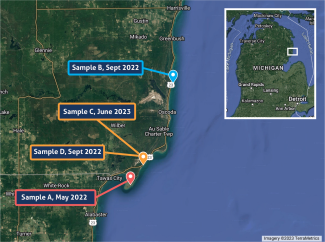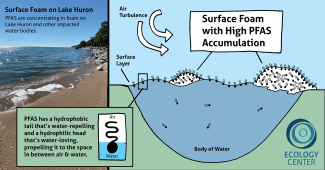A new report from the Ecology Center and partners points to the urgency of increased public awareness and education on Oscoda’s beaches
With twenty miles of sandy beaches, thousands of acres of wetlands and wildlife reserves, and renowned trout fishing on the Au Sable River, Oscoda, Michigan, is a beloved destination for summer vacationers. But within this watery haven lies a tragic, toxic secret: PFAS contamination.
For beach lovers, the news is even more grim. The shores of Oscoda can be full of lake foam, and some of this foam may be toxic. Surface water foam can contain up to 5,000 times greater concentrations of PFAS than the surrounding water. And without ample monitoring or public advisories to avoid the Lake Huron foam, people may be unwittingly exposed to toxic PFAS.
To address this urgent concern, Need Our Water (NOW), the Ecology Center, and the National Wildlife Federation Great Lakes Regional Center developed a community-based monitoring project. Oscoda community members collected lakeshore foam for analysis to better understand the scale of the contamination and use the data to advocate for stronger state regulations and awareness.
Between 2022 and 2023 , NOW volunteers collected foam samples in four different areas along Lake Huron near Oscoda. All four samples contained PFAS, though Tawas Point State Park had the highest concentrations at 7,900 ppt. PFOS and PFUnA were found in every sample, among others.

Based on the results, the community and environmental partners developed two recommendations to protect the health of residents and visitors. First, the group is asking Michigan’s Department of Environment, Great Lakes, and Energy (EGLE) and Michigan Department of Health and Human Services (MDHHS) to develop health-protective policies for Lake Huron foam. These include publicly available test data, foam advisories on Lake Huron, and increased public education. They are also asking for permanent signage on Lake Huron’s high-use beaches and shorelines to educate the public on visual indications of PFAS foam and alert them about the dangers of touching it.
"Since 2017 we've noticed significant foam events on Lake Huron. Repeatedly we asked EGLE to test the foam for PFAS and they repeatedly refused. We felt gaslighted when they told us the foam was a “natural” type of foam, so we tested the foam ourselves. We found there is nothing natural about the PFAS foam in Lake Huron." - Cathy Wusterbarth, NOW Co-Leader and member of Great Lakes PFAS Action Network
The full report can be reviewed here.
PFAS Pollution in Oscoda
Per- and polyfluoroalkyl substances (PFAS) are a class of thousands of chemicals widely used in manufacturing and consumer products. PFOS and PFOA were phased out but continue to pollute our environment, along with newer PFAS.
EGLE first detected PFAS in the groundwater and water bodies in Oscoda in 2010. They issued “Do Not Eat” advisories for fish and wildlife, and warned residents not to touch the shaving cream-like foam oozing up on the shores of Van Etten Lake, which borders the contaminated Wurtsmith Air Force Base. However, EGLE declined to conduct more extensive testing or monitoring of foam on Lake Huron, noting the state has no standard for surface water foam.
The community grew increasingly frustrated with the lack of state action being taken to monitor and address PFAS pollution on Lake Huron. In 2017, Oscoda residents formed the grassroots group Need Our Water (NOW) to engage residents in fighting for clean water and protecting wildlife and human health. In 2021, NOW joined the Ecology Center, the National Wildlife Federation, and the Michigan League of Conservation Voters to form the Great Lakes PFAS Action Network (GLPAN). This community-driven coalition has developed community-based science monitoring projects for PFAS and a series of policy recommendations for elected officials to turn off the tap on PFAS pollution.
Community members and fellow advocates concerned about PFAS pollution can get involved with the GLPAN. View the website to learn about our policy recommendations, and sign up for the newsletter to learn about upcoming events and ways to get involved.



